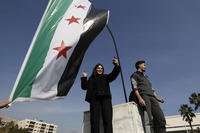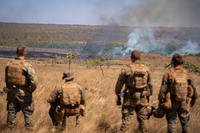MANILA, Philippines -- Personnel and aircraft with III Marine Expeditionary Force are providing humanitarian assistance and disaster relief support at the request of the Philippine government in the wake of Typhoon Pablo which struck Dec. 4.
Marines with 3rd Marine Expeditionary Brigade, who were in Manila conducting planning for future bilateral training exercises with the Armed Forces of the Philippines, stood up the III MEF forward command element Dec. 8 to support Philippine relief efforts.
“The III MEF forward command element has established the bilateral coordination center, which is providing command and control for U.S. Marine relief efforts and coordinating requests for support with the government and Armed Forces of the Philippines, U.S. Embassy and Office of U.S. Foreign Disaster Assistance, part of the U.S. Agency for International Development,” said Marine Corps Col. Mark J. Menotti, the officer in charge of the III MEF FCE.
“We have personnel with the Armed Forces of the Philippines, Pacific Air Forces, OFDA, Joint-U.S. Military Assistance Group-Philippines and Joint Special Operations Task Force-Philippines in the bilateral coordination center in order to prioritize and synchronize humanitarian assistance and relief efforts, which ultimately makes that coordination more efficient,” Menotti added.
Two KC-130J Hercules aircraft with Marine Aerial Refueler Transport Squadron 152 arrived in Manila from Marine Corps Air Station Futenma, Japan, Dec. 8 to transport relief supplies to affected areas, according to Marine Corps Lt. Col. Jason W. Julian, the commanding officer of VMGR-152, part of Marine Aircraft Group 36, 1st Marine Aircraft Wing, III MEF.
“As of Dec. 12, VMGR-152 has flown a total of 11 flights and transported approximately 330,000 lbs. of relief supplies, including 14,500 family ration packs, 500 relief aid boxes and 40 generators,” Julian said. “We also transported four water purification specialists and three personnel from USAID and the Philippine Department of Social Welfare and Development were transported to Davao. It’s critical we work with everyone involved in the relief efforts to expediently get these supplies to those affected by the typhoon and in need.”
The squadron also has transported 49,000 pounds of rice, 147 bundles of mosquito nets, one water purification unit, approximately 29,000 pounds of blankets, 833 sleeping mats and a United Nation’s World Food Program relief module and three of their tents.
Marines transported relief supplies from Villamor Air Base located in Manila to Davao International Airport in Mindanao, the region most affected by the typhoon. From Davao, the supplies were principally distributed by government and nongovernmental organizations to displaced families affected by the typhoon as directed by the Philippine government..
“We’re seeing a collective response from the international community to support the Philippines,” Menotti said. “We are happy to help our close allies, standing shoulder-to-shoulder in order to provide necessary aid. The U.S. government -- including U.S. Marine forces -- is providing robust logistical and aviation support to quickly deliver life-saving supplies in support of humanitarian assistance and disaster relief efforts.”
The U.S. military has partnered and trained with the Armed Forces of the Philippines for many years in humanitarian assistance and disaster relief operations, Menotti said.
“We frequently prepare for situations like this with our Philippine allies, so we are ready to work together to support the Philippine government and its citizens during this difficult time,” he said. “Our goal is to help our ally recover from this natural disaster in whatever way we can.”

























